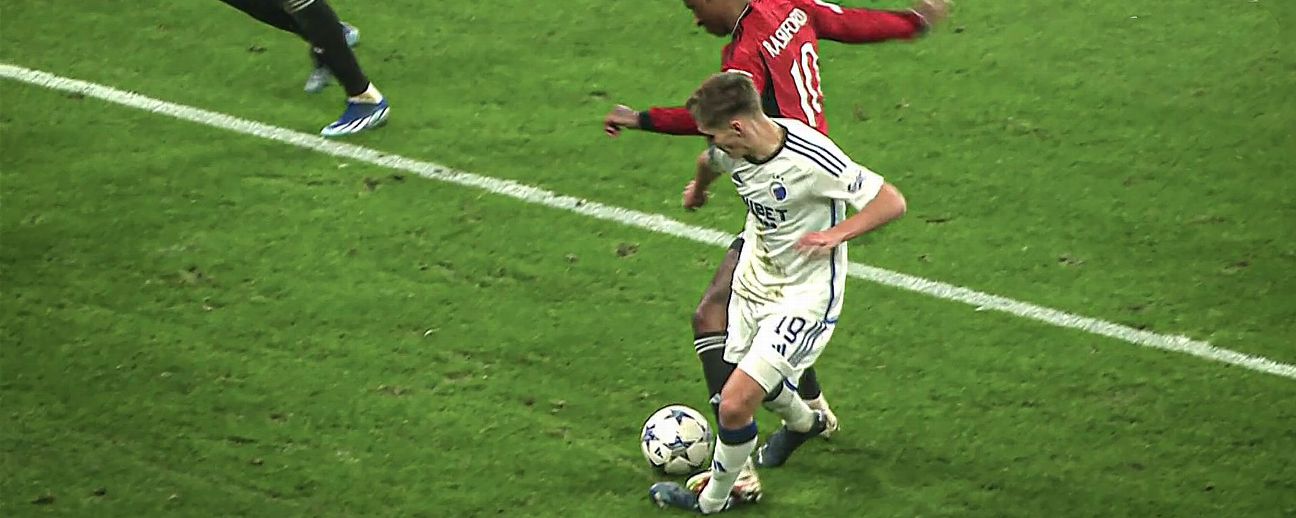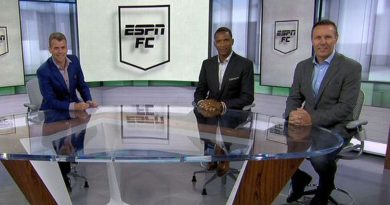The VAR Review: Rashford sent off for Man United; handballs, offside

The video assistant referee (VAR) doesn’t seem to cause as much controversy in the Champions League, with the cream of Europe’s referees involved, but every now and then a game does hit the headlines.
– How VAR decisions have affected every Prem club in 2023-24
– VAR in the Premier League: Ultimate guide
FC Copenhagen‘s dramatic 4-3 win over Manchester United on Wednesday was filled with incidents, with a VAR red card and two penalties, as well as possible offside decisions and handball claims. We take a look at all the drama.
39th minute: Rashford sent off
What happened: Marcus Rashford took control of the ball just outside the FC Copenhagen area under pressure from Elias Jelert. The Manchester United forward attempted to shield the ball, with the left-back going to ground after contact from the striker. Referee Donatas Rumsas allowed play to continue, but the VAR, Tomasz Kwiatkowski, began a review for serious foul play.
VAR decision: Red card.
1:52
Why Burley has ‘no doubt’ Marcus Rashford deserved a red card
Craig Burley believes Manchester United’s Marcus Rashford did deserve to be sent off for his tackle vs. FC Copenhagen in the UEFA Champions League.
VAR review: As has been explained in our Premier League VAR Review in the past, a few things are taken into consideration when evaluating whether a player has endangered the safety of an opponent. One is contact high above the boot with the studs, another is the buckle of the ankle to indicate a level of force.
Rashford is unfortunate in that he wasn’t making a tackle, yet intent was taken out of the laws several years ago. Instead, a player is expected to be aware of where their opponent is and not play in a way that could cause them injury.
Many former players have said they disagree with Rashford being sent off, but in the modern game this is always likely to be a red card — especially with the video referee watching everything again.
There will be questions about the referee being shown the incident in slow motion, and a freeze frame of point of contact. Yet the point of the pitchside monitor is always lost in this: the screen exists to present the evidence for the referee to change his decision, and not for a second look. It’s not an impartial process, but it’s not meant to be — because the point of the VAR process is that a clear and obvious error has already been identified. It’s always going to be an area that supporters will struggle to grasp, especially as the lawmakers continue to refuse to allow the broadcast of the discussion with the VAR.
There was confusion because at one point, the VAR message on the television broadcast said “check over” before the referee then went to the screen to make the decision. UEFA also initially incorrectly said the red card was for a flailing arm before correcting it to serious foul play.
45th minute: Possible offside on Elyounoussi goal
What happened: Mohamed Elyounoussi brought FC Copenhagen back into the game when he turned home a pass from Diogo Gonçalves, but was there an offside against Elias Achouri?
VAR decision: Goal stands.
VAR review: Achouri was definitely in an offside position when Elyounoussi hit his shot, it’s just a matter of whether or not Manchester United goalkeeper André Onana was impacted. Achouri being in that position isn’t in itself an offence.
Was Achouri in Onana’s line of vision? It’s close, but it looks like Onana does just have a view to the ball. The VAR would also take into account that the shot went to Onana’s left (rather than close to Achouri).
Achouri is also moving away from the path of the ball, rather than towards it, and makes no movement to attempt to play it.
It’s the kind of subjective decision that is left to the on-field officials. If the assistant had flagged it, the goal would have stayed disallowed.
45+7 minutes: Penalty for handball by Maguire
What happened: FC Copenhagen equalised deep into first-half added time when the referee awarded a spot kick for handball by Harry Maguire.
VAR decision: Penalty stands, scored by Gonçalves.
VAR review: Gonçalves attempted to nudge on a cross played into the box, which came off the thigh of Raphaël Varane and onto his arm. The defender had his arm by his side, so there was no handball here.
The ball then came back to Gonçalves, who attempted to flick the ball around — but it hit the outstretched arm of Maguire and the referee immediately pointed to the spot.
If this decision has been given by the match referee, there’s no chance of a VAR intervention — especially in Europe.
However, in the Premier League, which has a more relaxed interpretation of handball, the referee may well consider the touch on Maguire’s arm to be the consequence of his movement when challenging an opponent from close proximity.
66th minute: Penalty for handball by Lerager
What happened: The ball was played into the Copenhagen area, with Lukas Lerager challenging Maguire for the ball. It hit the arm of Lerager but the referee allowed play to continue.
VAR decision: Penalty, scored by Bruno Fernandes.
VAR review: This is a classic UEFA handball penalty, the kind that would not be awarded through a VAR decision in the Premier League. Indeed, Maguire avoided a handball penalty earlier this year in similar circumstances against Nottingham Forest.
Maguire nods the ball onto his own hand, and then onto the arm of Lerager from point-blank range. The FC Copenhagen player is in a genuine challenge for the ball with both Maguire and Varane, has his arm in an expected position for his movement and isn’t creating an obvious barrier.
If a player (Maguire) deliberately heads the ball and it hits their own arm it cannot be handball — even if the arm is away from the body. Then it’s decided that the position of Lerager’s arm away from his body is a handball offence — despite the proximity.
Earlier this year, the newly created UEFA football board, made up of former players and coaches, urged for more clarity on the handball law. However, it seems as confusing and frustrating as ever, not to forget inconsistent across competitions.

